 W
WPurple parchment, purple vellum or codex purpureus refers to manuscripts written on parchment dyed purple. The lettering may be in gold or silver. Later the practice was revived for some especially grand illuminated manuscripts produced for the emperors in Carolingian art and Ottonian art, in Anglo-Saxon England and elsewhere. Some just use purple parchment for sections of the work; the 8th-century Anglo-Saxon Stockholm Codex Aureus alternates dyed and un-dyed pages.
 W
WThe Codex Argenteus is a 6th-century manuscript, originally containing part of the 4th-century translation of the Bible into the Gothic language. Traditionally ascribed to bishop Ulfilas, it is now established that the Gothic translation was performed by several scholars, possibly under Ulfilas's supervision. Of the original 336 folios, 188—including the Speyer fragment discovered in 1970—have been preserved, containing the translation of the greater part of the four gospels. A part of it is on permanent display at the Carolina Rediviva building in Uppsala, Sweden.
 W
WCodex Purpureus Beratinus designated by Φ or 043, ε 17, is an uncial illuminated manuscript Gospel book written in Greek. Dated palaeographically to the 6th-century, the manuscript is written in an uncial hand on purple vellum with silver ink. The codex is preserved at the Albanian National Archives in Tirana, Albania. It was formerly possessed by the St. George Church in the town of Berat, Albania, hence the 'Beratinus' appellation.
 W
WThe Codex Brixianus, designated by f, is a 6th-century Latin Gospel Book which was probably produced in Italy.
 W
WCodex Petropolitanus Purpureus, designated by N or 022, ε 19 (Soden), is a 6th-century Greek New Testament codex gospel book. Written in majuscules, on 231 parchment leaves, measuring 32 x 27 cm. Paleographically it has been assigned to the 6th century.
 W
WThe title Codex Vercellensis Evangeliorum refers to two manuscript codices preserved in the cathedral library of Vercelli, in the Piedmont Region, Italy.
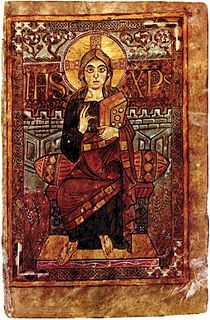 W
WThe Godescalc Evangelistary, Godescalc Sacramentary, Godescalc Gospels, or Godescalc Gospel Lectionary is an illuminated manuscript in Latin made by the Frankish scribe Godescalc and today kept in the Bibliothèque nationale de France. It was commissioned by the Carolingian king Charlemagne and his wife Hildegard on October 7, 781 and completed on April 30, 783. The Evangelistary is the earliest known manuscript produced at the scriptorium in Charlemagne's Court School in Aachen. The manuscript was intended to commemorate Charlemagne's march to Italy, his meeting with Pope Adrian I, and the baptism of his son Pepin. The crediting of the work to Godescalc and the details of Charlemagne's march are contained in the manuscript's dedication poem.
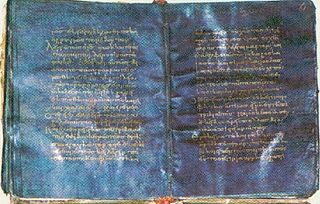 W
WMinuscule 565, ε 93 (Soden), also known as the Empress Theodora's Codex, is a Greek minuscule manuscript of the New Testament, written on purple parchment, dated palaeographically to the 9th century. It was labelled by Scrivener as 473. The manuscript is lacunose. It has marginalia.
 W
WMinuscule 1143, ε 1035, also known as the Beratinus 2, or Codex Aureus Anthimi. It is a Greek minuscule manuscript of the New Testament on purple parchment, dated paleographically to the 9th century. This is one of the seven “purple codices” in the world to have survived to the present day, and one of the two known purple minuscules written with a gold ink.
 W
WThe Rossano Gospels, designated by 042 or Σ, ε 18 (Soden), held at the cathedral of Rossano in Italy, is a 6th-century illuminated manuscript Gospel Book written following the reconquest of the Italian peninsula by the Byzantine Empire. Also known as Codex purpureus Rossanensis due to the reddish-purple appearance of its pages, the codex is one of the oldest surviving illuminated manuscripts of the New Testament. The manuscript is famous for its prefatory cycle of miniatures of subjects from the Life of Christ, arranged in two tiers on the page, sometimes with small Old Testament prophet portraits below, prefiguring and pointing up to events described in the New Testament scene above.
 W
WThe Sinope Gospels, designated by O or 023, ε 21 (Soden), also known as the Codex Sinopensis, is a fragment of a 6th-century illuminated Greek Gospel Book. Along with the Rossano Gospels, the Sinope Gospels has been dated, on the basis of the style of the miniatures, to the mid 6th-century. The Rossano Gospels, however are considered to be earlier. Like Rossanensis and the Vienna Genesis, the Sinope Gospels are written on purple dyed vellum.
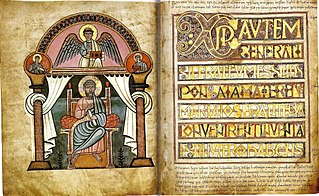 W
WThe Stockholm Codex Aureus is a Gospel book written in the mid-eighth century in Southumbria, probably in Canterbury, whose decoration combines Insular and Italian elements. Southumbria produced a number of important illuminated manuscripts during the eighth and early ninth centuries, including the Vespasian Psalter, the Stockholm Codex Aureus, three Mercian prayer books, the Tiberius Bede and the British Library's Royal Bible.
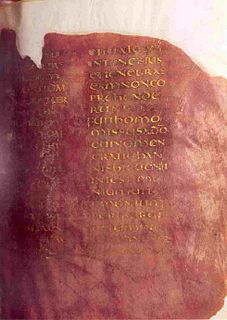 W
WThe Codex Veronensis, designated by siglum b or 4, is 5th century Latin Gospel Book. The text, written on purple dyed vellum in silver and occasionally gold ink, is a version of the old Latin. The Gospels follow in the Western order.
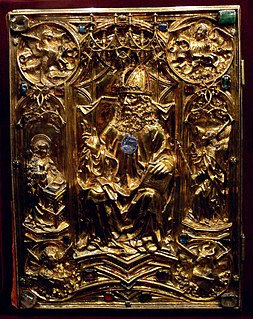 W
WThe Vienna Coronation Gospels, also known simply as the Coronation Gospels, is a late 8th century illuminated Gospel Book produced at the court of Charlemagne in Aachen. It was used by the future emperor at his coronation on Christmas Day 800, when he placed three fingers of his right hand on the first page of the Gospel of Saint John and took his oath. Traditionally, it is considered to be the same manuscript that was found in the tomb of Charlemagne when it was opened in the year 1000 by Emperor Otto III. The Coronation Evangeliar cover was created by Hans von Reutlingen, c. 1500. The Coronation Evangeliar is part of the Imperial Treasury (Schatzkammer) in the Hofburg Palace in Vienna, Austria.
 W
WThe Vienna Genesis, designated by siglum L (Ralphs), is an illuminated manuscript, probably produced in Syria in the first half of the 6th Century. It is the oldest well-preserved, surviving, illustrated biblical codex.